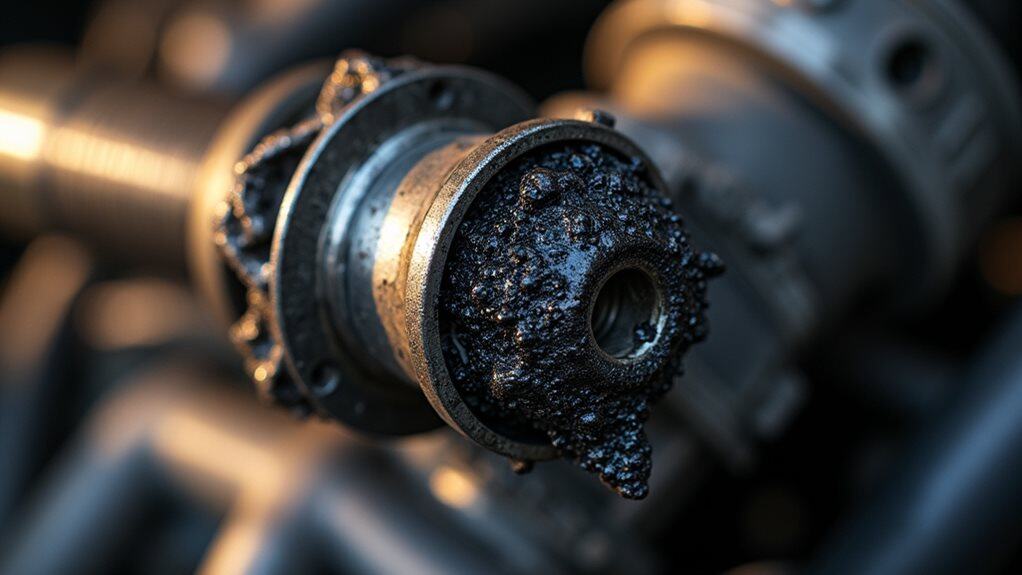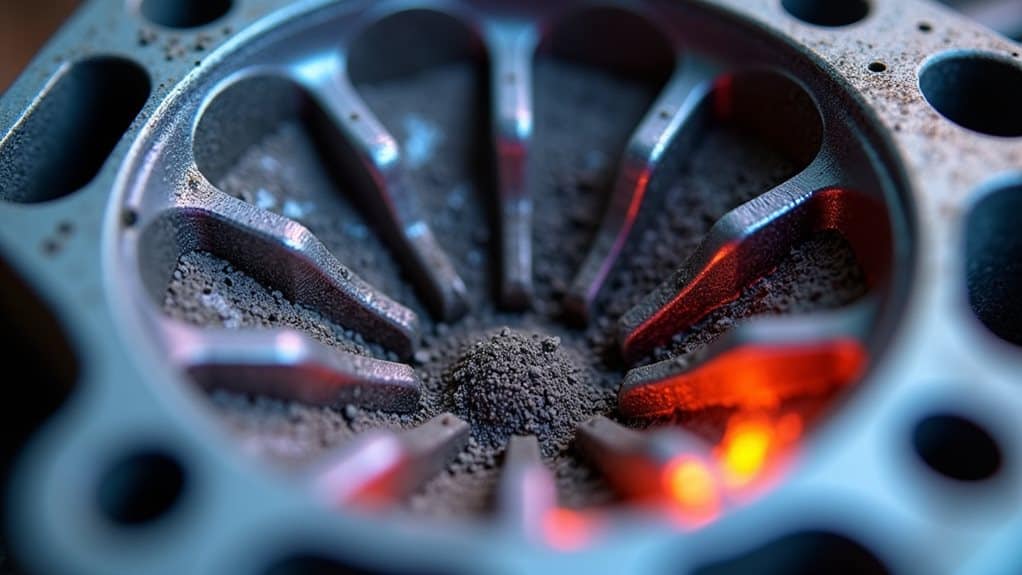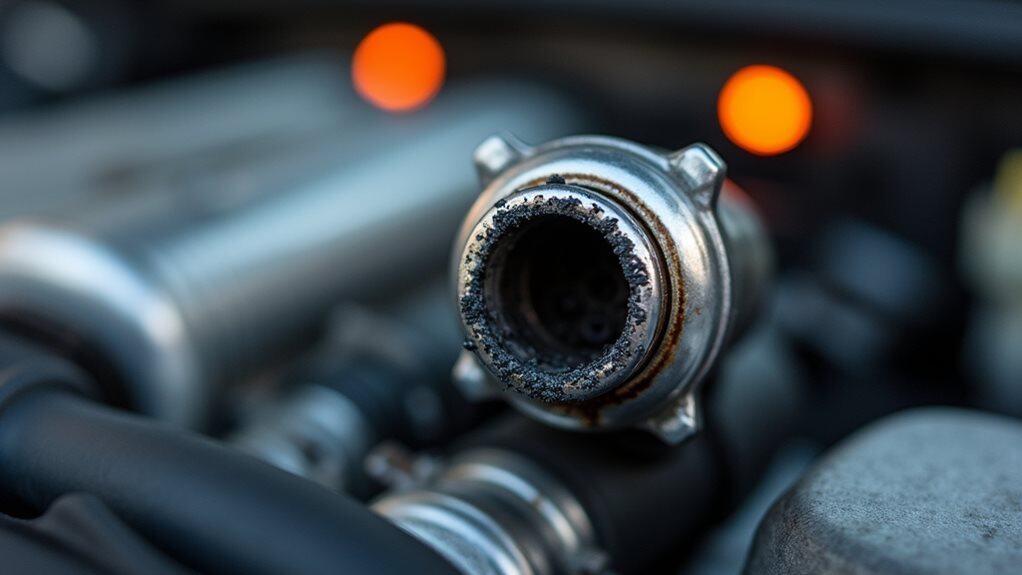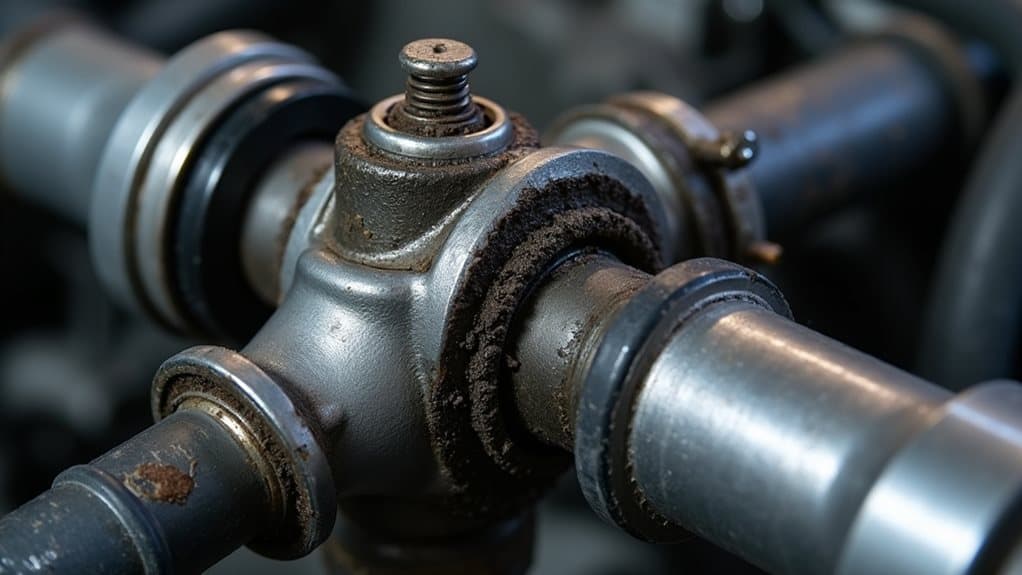When your EGR valve sticks closed, you’ll notice sluggish acceleration, reduced power at higher speeds, and decreased fuel economy as your engine compensates for disrupted air-fuel mixtures. Your check engine light will illuminate, often triggering diagnostic code P0401 for insufficient EGR flow. Combustion temperatures exceed normal limits, causing engine knock and rough idling that worsens over time. These overheating effects can damage pistons, crack engine blocks, and blow head gaskets if left unaddressed, making early detection essential for preventing costly repairs.
Quick Tips
- Check engine light illuminates with diagnostic trouble code P0401 indicating insufficient EGR flow detected by onboard systems.
- Engine experiences sluggish acceleration, hesitant throttle response, and jerky performance especially at higher speeds.
- Fuel economy noticeably drops as engine burns more fuel to compensate for disrupted air-fuel mixture ratios.
- Combustion chamber overheating causes knocking sounds, pre-ignition, and temperatures exceeding 280°F that can warp pistons.
- Idle quality deteriorates from normal to rough and uneven as combustion temperatures remain excessively high.
Engine Performance Problems and Power Loss

When your EGR valve becomes stuck in the closed position, you’ll notice a cascade of engine performance issues that stem from one fundamental problem: excessively hot combustion temperatures.
Without exhaust gas recirculation cooling the combustion chamber, your engine experiences knock retard, which reduces power output and creates jerky acceleration, particularly during part-throttle conditions. You’ll typically notice these performance declines more prominently at higher speeds, as the closed valve prevents proper exhaust gas flow during demanding driving conditions. Additionally, prolonged overheating can lead to severe engine damage, exacerbating the performance problems caused by the stuck EGR valve.
Fuel Economy Decline and Emissions Issues
When your EGR valve sticks closed, you’ll notice your vehicle’s fuel economy drops markedly as the engine burns more fuel to compensate for the disrupted air-fuel mixture. This occurs because a high air/fuel ratio can lead to incomplete combustion, which further exacerbates the fuel efficiency issue.
This decreased efficiency means you’ll find yourself visiting gas stations more frequently, even though your driving habits haven’t changed. Additionally, your vehicle will likely fail emissions testing because the closed EGR valve allows combustion temperatures to rise, which increases harmful NOx emissions beyond acceptable legal limits. You may also experience engine knocking during acceleration as the higher combustion temperatures create abnormal pressure waves in the cylinders.
Poor Fuel Efficiency
As your EGR valve becomes stuck in the closed position, you’ll likely notice your vehicle’s fuel efficiency taking a noticeable hit at the gas pump.
Without exhaust gas recirculation, combustion temperatures rise dramatically, causing your engine to burn fuel less efficiently. This leads to incomplete combustion cycles and forces your engine’s control system to compensate with additional fuel.
Failed Emissions Testing
If your EGR valve becomes stuck in the closed position, you’ll likely face significant challenges during your next emissions test.
Without exhaust gas recirculation, combustion temperatures rise dramatically, causing nitrogen oxides (NOx) levels to exceed regulatory limits.
Additionally, incomplete combustion increases carbon monoxide and hydrocarbon emissions, making it nearly impossible to pass standard environmental compliance testing.
Combustion Chamber Overheating Effects

Although your EGR valve’s primary function involves reducing combustion temperatures, a stuck-closed valve creates a cascade of destructive overheating effects throughout your engine’s combustion chambers.
You’ll experience temperatures exceeding 280°F, which warps piston surfaces and damages ring grooves.
This allows combustion pressure to leak into your crankcase, while pre-ignition causes knocking sounds and potential piston melting. Additionally, prolonged overheating can lead to internal damage such as cracked engine blocks and blown head gaskets.
Idle Quality and Acceleration Difficulties
Beyond the destructive heat buildup in your combustion chambers, a stuck-closed EGR valve creates noticeable problems with how your engine runs during everyday driving.
You’ll experience sluggish acceleration and hesitant throttle response because heightened combustion temperatures reduce engine efficiency.
Your idle quality may seem normal initially but deteriorates over time, becoming rough and uneven. Additionally, irregular shifts from the transmission can exacerbate the feeling of poor acceleration, making the driving experience even more uncomfortable.
Warning Signs and Diagnostic Indicators

When your EGR valve becomes stuck in the closed position, your vehicle’s onboard diagnostic system typically detects the malfunction and illuminates the check engine light on your dashboard.
Common diagnostic trouble codes include P0401, which indicates insufficient EGR flow.
You’ll need an OBD-II scanner to retrieve these codes and confirm the valve’s stuck-closed condition for proper diagnosis.
Maintenance Considerations and Prevention
Since prevention proves far more cost-effective than repair, implementing proper maintenance practices for your EGR valve can save you hundreds of dollars in future repairs while keeping your vehicle running smoothly.
You’ll need regular inspections, high-quality fuel, and adherence to manufacturer schedules.
Don’t delay addressing symptoms like rough idling—early professional intervention prevents extensive damage.
Wrapping Up
You’ll notice a stuck-closed EGR valve through reduced engine performance, poor fuel economy, and rough idling. Your engine may knock, overheat, or struggle during acceleration. Don’t ignore these warning signs—they indicate serious combustion issues that’ll worsen without attention. Regular maintenance prevents most EGR problems, but when symptoms appear, you need immediate diagnosis and repair. Address these issues promptly to avoid costly engine damage and maintain your vehicle’s efficiency and emissions compliance.

